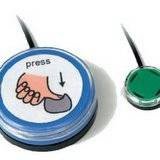Here is the handout from my presentation at the IU 13 Conference in Lancaster, PA on June 17th.
Web 2.0 to Improve Student Achievement
Beth Poss
possbeth@gmail.com
handout available at
http://matnonline.pbwiki.com
Universal Design for Learning = Front loading for Flexibility = Digital Media = Access for All Students = Improved Student Achievement
What is a Blog?
As defined by Wikipedia, "A blog (a portmanteau of web log) is a website where entries are commonly displayed in reverse chronological order. "Blog" can also be used as a verb, meaning to maintain or add content to a blog." ( Wikipedia) Essentially, a blog is an online journal that allows readers of the journal to offer comments and feedback.
Blogging allows you to easily create a simple webpage that generally is a place to post your unique ideas and information that you think is of value to others. Other characteristics of weblogs include archives, a unique URL for each post (called a permalink), an RSS feed to syndicate the blog’s content, dated and time-stamped entries, the capability of the software to allow readers’ comments, and use of templates to assist in page design and layout. (See Parts of a Blog.)
Blogs have become very popular because they can be used in so many ways, from personal diaries to online portfolios to announcements to commentaries on politics and world events. They can be written, edited, and updated from any computer with Internet access at any time of the day or night. Through the ability to comment, readers of blogs can interact with the author, and with hot links, they can point to related sites and ideas. Blogs have become an accepted form of communication and a way to express and explore ideas. They give writers a public voice. In education, blogs have become a forum to encourage students to write and express their ideas while receiving feedback from teachers, their peers, and even the larger world, when a blog is made public.
One who blogs is a "blogger."
Blogs to check out:
Students Blogging
http://students2oh.org/
http://web.mac.com/g4husky/Husky_Howler_Network/Howler_Blog/Howler_Blog.html
http://vcs.21classes.com/
http://fhsblogs.21classes.com/
Teachers/Educators Blogging
http://www.teachingeverystudent.blogspot.com/
http://coolcatteacher.blogspot.com/
http://perkone.edublogs.org/
http://snobles.blogspot.com/
What is a Wiki?
"A wiki is software that allows users to create, edit, and link web pages easily. Wikis are often used to create collaborative websites and to power community websites. These wiki websites are often also referred to as wikis." (Wikipedia) Wikis allow anyone to create or edit a website or webpages with little or no knowledge of hypertext markup language (html). Wikis and wiki pages can be password protected, however, to control who can edit. Wikis allow for collaboration on projects and promote ideas.
A wiki is like a blank webpage you can write on with simple tools--text, photos, graphics, videos, links and more. Wikis store the history of page changes so you can see how a page has changed over time, and can revert to an older version if you'd like.
For students, wikis are an opportunity to engage in a collaborative writing process. Wikis are also a great way to engage in and organize group research projects, as each individuals contributions can easily be seen in the history and revisions.
Wikis to check out:
www.wikipedia.org
http://simple.wikibooks.org/wiki/Main_Page
http://www.matnonline.com
http://weblogged.wikispaces.com
http://schools.wikia.com/wiki/High_School_Online_Collaborative_Writing
Want to create a wiki?
www.wikispaces.com
www.pbwiki.com
What is Social Bookmarking?
Social bookmarking is a method for Internet users to store, organize, search, and manage bookmarks of web pages on the Internet with the help of metadata.
In a social bookmarking system, users save links to web pages that they want to remember and/or share. These bookmarks are usually public, and can be saved privately, shared only with specified people or groups, shared only inside certain networks, or another combination of public and private domains. The allowed people can usually view these bookmarks chronologically, by category or tags, or via a search engine. (Wikipedia)
It is tagging or marking a website, like you would a favorite. However, instead of saving them to your web browser, you are saving them to the web. Never again have trouble remembering the URL of a website you want to go back to. Since the bookmarks are online, you can easily share them with friends, students, colleagues, etc.
Bookmarking sites to check out:
http://www.diigo.com
http://del.icio.us
What is Photo Sharing?
"Photo sharing is the publishing or transfer of a user's digital photos online, thus enabling the user to share them with others (whether publicly or privately). This functionality is provided through both websites and applications that facilitate the upload and display of images." ( Wikipedia)
Once the photos are online, different photo sharing sites offer a variety of tools to organize, print, display, edit, annotate, tag, manipulate, and use them.
You can add "tags" or keywords to your photos. That will help you organize, sort and find information.
Photo sharing sites to check out:
http://www.flickr.com/
http://picasa.google.com
What is Podcasting?
A podcast is a series of digital-media files which are distributed over the Internet using syndication feeds for playback on portable media players and computers. The term podcast, like broadcast, can refer either to the series of content itself or to the method by which it is syndicated; the latter is also called podcasting. The host or author of a podcast is often called a podcaster.
The term is a portmanteau of the words "iPod" and "broadcast",[1] the Apple iPod being the brand of portable media player for which the first podcasting scripts were developed (see history of podcasting). Such scripts allow podcasts to be automatically transferred to a mobile device after they are downloaded. (Wikipedia).
http://oedb.org/library/beginning-online-learning/100-ways-to-use-your-ipod-to-learn-and-study-better
Podcasts to check out:
http://www.mpsomaha.org/willow/Radio/
http://www.princetonreview.com/vocabminute
:
Beth Poss 2008 possbeth@gmail.com








